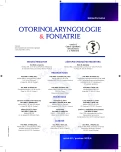Complications after BAHA Implantation
Authors:
S. Krempaská; J. Kovaľ
Authors‘ workplace:
Klinika otorinolaryngológie a chirurgie hlavy a krku UNLP, Košice
primár prof. MUDr. J. Kovaľ CSc.
Published in:
Otorinolaryngol Foniatr, 62, 2013, No. 4, pp. 186-190.
Category:
Original Article
Overview
Complications associated with BAHA implantation may occur during the surgery, but also in the postoperative period of healing. The complications during surgery are rare and can be easily managed. They include strong bleeding form skin, muscles and emissary veins. Sigmoid sinus and dura mater can be exposed, but their damage is rare. Complications occurring in the postoperative period are distinguished into osseointegration (sc. osseous) ones, and complications in healing of soft tissues. Early osseous complications originate as a consequence of erroneous osseointegration, whereas late osseous complications resulting from disintegration due to trauma or inflammation. The complications of soft tissue healing include skin reddening, wound weeping, formation of granulation tissue, skin overgrowth below the graft and partial or total necrosis of the lobe. Most complications can be manages by intensive conservative therapy, surgical treatment is required mostly in patients with overgrowth of tissue below bone anchor.
There were no perioperative complications in our group. In the postoperative period one patient suffered from a bad osseointegration, six patients experienced prolonged and complicated healing and in two of them surgical intervention became necessary. A standard healing occurred in the other 80% of patients. The selection of patients, adherence to operation technique and correct postoperative care significantly decrease the risk of development of complications.
Keywords:
BAHA, bone vibrator anchored in the skull, complications in hearing rehabilitation
Sources
1. Berenholz, L. P., Burkey, J. M., Lippy, W. H.: High body mass index as a risk factor for skin overgrowth with bone-anchored hearing aid. Otol. Neurotol., 31, 2010, s. 430-432.
2. Cox, R. M., Alexander G. C.: The Abbreviated profile of hearing aid benefit. Ear and Hearing, 16, 1995, s. 176-186.
3. House, J. W., Kutz, J. W.: Bone-anchored hearing aids:incidence and management of postoperative complications. Otol.Neurotol., 28, 2007, s. 213-217.
4. McDermott, A. L., Sheehan, P.: Bone anchored hearing aids in children. Otolaryngol. Head Neck Surg., 17, 2009, s. 488-493.
5. Kabelka, Z., Šupáček, I.: Sluchadla zakotvená do kosti – sluchadla s přímým přenosem zvukové vibrace na kost – BAHA systém. Otorinolaryngol./Prague/, 48, 1999, 3, s. 135-138.
6. Kompis, M.: Audiologie. Has Huber, Bern, 2009, 236 s.
7. Noyek, A. M., Maniglia, A. J.: Congenital disorders in otolaryngology in the otolaryngologic clinics of North Amerika. W. B. Sauders Company, Philadelphia, 14, 1981, 1, s. 1-261.
8. Snik, A., Leijendeckers, J., Hol, M. et al.: The bone-anchored hearing aid for children: Recent developments. Int J. Audiol., 47, 2008, s. 554-559.
9. Tjellstrom, A., Granstrom, G.: How we do it:frequency of skin necrosis after BAHA surgery. Clin. Otolaryngol., 31, 2006, s. 216-232.
10. Wazen, J. J., Young, D. L., Farrugia, M. C. et al.: Successes and complications of the BAHA system. Otol. Neurotol., 29, 2008, s. 1115-1119.
Labels
Audiology Paediatric ENT ENT (Otorhinolaryngology)Article was published in
Otorhinolaryngology and Phoniatrics

2013 Issue 4
Most read in this issue
- Narrow Band Imaging (NBI) - Endoscopic Method for Head and Neck Squamous Cell Carcinoma Diagnostics
- Electrostimulation of Immobile Vocal Cord – Modification of the Method
- Surgical Treatment of Salivary Glands Tumor Lesions in the Five-Year Period
- Voice Range Profile Parameters in Diagnostics and Voice Research
